Effect of Water Bodies in a Space
Water plays an important role in the formation of human life. But when we perceive water
in the architectural sense, water finds a special place from an artistic point of view. Water is
clear, fluid, calm, and quiet. The architecture utilizes all these water features and so the
relationship between man and water can be shown in the architecture of any space.
Water in architecture
Water is a multidimensional object which appears in various fields:
- Environmentally: Is a natural resource for living
- Socially: A sensitive basis for developing human activities
- Financially: It influences tourism, agriculture, fisheries, etc
- Culturally: Related to folklore, mythology, art, and religion
- Aesthetically: Represented as a beautiful element of nature
Water is an important design element. Water flows, fluid, and formless. Not only is this
fluidity represented by actual bodies of water, but the element is also strappingly tied to
the way a plant adapts to the changing seasons. Like plants, water has qualities that change
over time and in different light and weather conditions. It is capable of producing a wide
diversity of effects from that of a still pond to the delight of a great cascade.
The most effective, palpable and comprehensible feature of water in the architecture is its
sign of formalism. The manifestation of water in architecture in different ways is the projection
of sentiments and ideas of designers. The special form of this discussion deals with the
objective effects of water in architecture and gardening which includes “centrality, forming,
inviting, bonding, separator, passing, running, dramatic and with the landscape “features in
environment and insists on this postulation that water in architecture is the main central
element, and is considered in the context and is not peripheral.
Indoor water features
While water elements usually belong outdoors in your backyard, there are ways to make
water features an indoor element when you can devote some extra space. Nowadays the
uses for water features are boundless, from small table-top features to accents and room
dividers. Having indoor water features is like living out a luxury in itself. Water features
look quite chic and graceful if placed appropriately and advantageously. Water features are
not restricted to mere fountains or indoor swimming pools. Water features are well used to
bring out a natural feel right inside your homes. The sound of the water creates quite a
relaxing effect and when put to use in your home exudes serenity and tranquility in the
surrounding. Let us explore a little of the few interesting water feature ideas:
Running stream
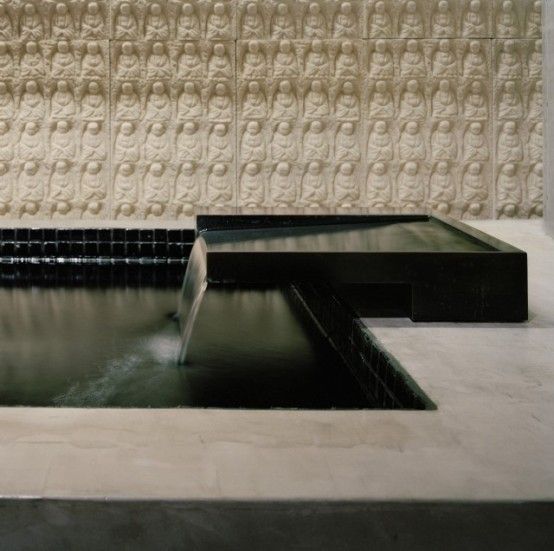
Water streams look quite attractive, especially if they are winding down through the living room amidst a stone floor. Indoor waterfalls running into a small stream through the home is quite an outlandish idea of including water features in homes.
Water fountains

Indoor fountains have a completely unique and enjoyable feel of their own. It does not necessarily have to be a very evident and large water feature with a fountain. Even a small makeshift waterfall pond proves to be sufficient enough to have an indoor water feature that catches great attention.
Water gardens

A water garden looks quite exotic, especially with those lovely, green tropical plants that can grow within the water garden. These indoor water features allow building a profligate and lavish water feature. It may be dedicated to a corner in the home, be it right beside the entrance or living
room or any other place where it is suitable to build water gardens and can give the inmates a pleasant and relaxed atmosphere.
Water body under the staircase
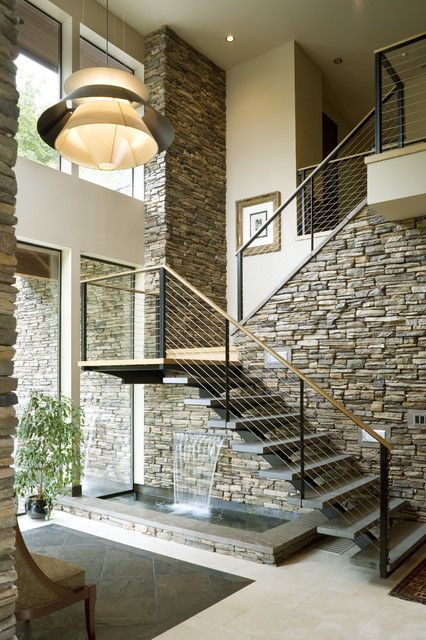
Having a water feature, a small pond like structure, right below a modern staircase is yet another way of bringing this natural element right into your home. If glass frames are on the staircase, then these will only enhance the beauty of under the stairs water feature creating a very unique feature.
Water in landscape architecture
Water has always maintained its place as one of the most important design
elements in successful designs concocted from the past to the present. The designs related to
water have always attracted people and provoked interest in them. Water has been used
for different purposes as a design element with its symbolic, visual, and auditory
features. It has helped to provide the effect which is desired to be created in design by
causing different reactions on people with different circumstances. The features of
water lie behind its boundless diversity. Water flowing at variable speeds (still, moving)
can be deep or shallow. It acquires numerous colors and creates different sounds.
Each feature of water gives life for different solicitation and space usage in landscape
designs. The movement and stillness factors are always included in the essence of designs
related to water.
The aesthetic purposes of the water are divided into five, these are visual, auditory,
psychological, tactile, and cooling purposes. Water has functional features as
well as aesthetic qualities. Water is also a material that is penetrable and can be used
for a purpose. The functional purposes of water are divided into three, there are recreation,
circulation control, and pragmatism.
Types of Waterscapes
First of all, water should be classified for the correct use of water elements in
designs. Classification is as follows;
| Category | Effect | Type |
| Still Water | _ | Pool Lake Pond |
| Active Water | Active waters from Top to Bottom under the influence of gravity Active waters from Bottom to Top by applying pressure | Waterfall Stream River Cascades Fountain Jets |
Water does not have its own shape, it takes the form of the location where it exists. Water,
which sometimes fills up the pools and is sometimes folding in valleys, is either still or
moving regardless of where it exists.
Still Water
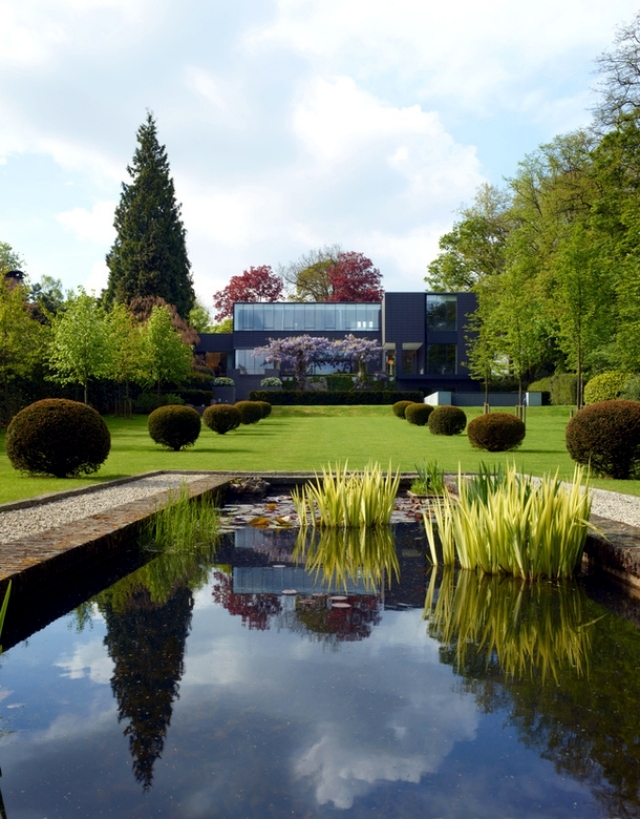
The water that conforms with the form of the ground on which it exists with the influence of gravity and is in a static state is called still water. Still water is visually lax and uninterruptedly gives the mind the possibility and encouragement of thinking with this feature. The still water element has also a soothing and calming feature in the area where it exists.
Along with the moisture and coolness it emits around, it has functions such as inviting people and bringing together the individuals around it as a focal point. The still water, which is used as the main element in designs, is used in quiet and passive areas to create a peaceful effect, and it is used in living areas to add significant air.
Still water surfaces have a reflective feature. It attracts people with the reflections created
by it. The reflective water elements are used in designs to create penetration, perpetuity,
and tranquility. The water surface adds dynamism and fantasy to space when it is supported
with light. Still water serving as a reflective and calm water mirror in designs expresses an
aesthetic value and has functional features.
Active waters

The active water which is visually exciting and sounds nice is an overriding element that adds life to space.The type of moving water depends on the scale and the state of the space where it is located. Horizontal and vertical movements in various forms can be added to water surfaces.
Active water is an important design element with its audio and visual effects. In the crowded urban life, moving waters create a more peaceful atmosphere by clearing annoying sounds in an otherwise overwhelming routine.
Purposes of Water element in Landscape Architecture
Water element is one of the most important components in open spaces. Water
element has different functions and different intended tenacities as a space component.
In this study, the intended purposes of water in landscape architecture were divided into
6 groups including edging, orienting, meaningful, focus, and continuality.
Edging
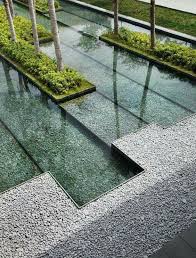
In general, “water” is an edging element inside the open space. Fittings and accessories can be fixed depending on the limits of the water element. In addition, a water element can be used as a limit the element that separates the activities in the space and provides the visual or auditory privacy, outside of its own functional duties.
Water plays a role in the space organization as a restrictive or closing element. For example, water sets a path such that a person has to walk around instead of passing through which gives a sense of confinement to space and acts as space dividers largely. The water element attracts the users’attention by preventing the noise via the sounds created by it in urban spaces with high levels of traffic noise.
Orienting
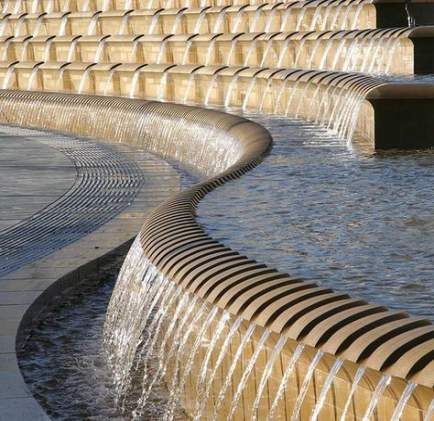
The water element also plays an orienting role in open spaces. The effect of the water element is substantial in the shaping of the space. It can direct people to the point which is desired to be accentuated according to its usage. The router water elements are also used to divert the traffic for security and safety and to ensure an orderly movement and progression inside the space.
Meaningful
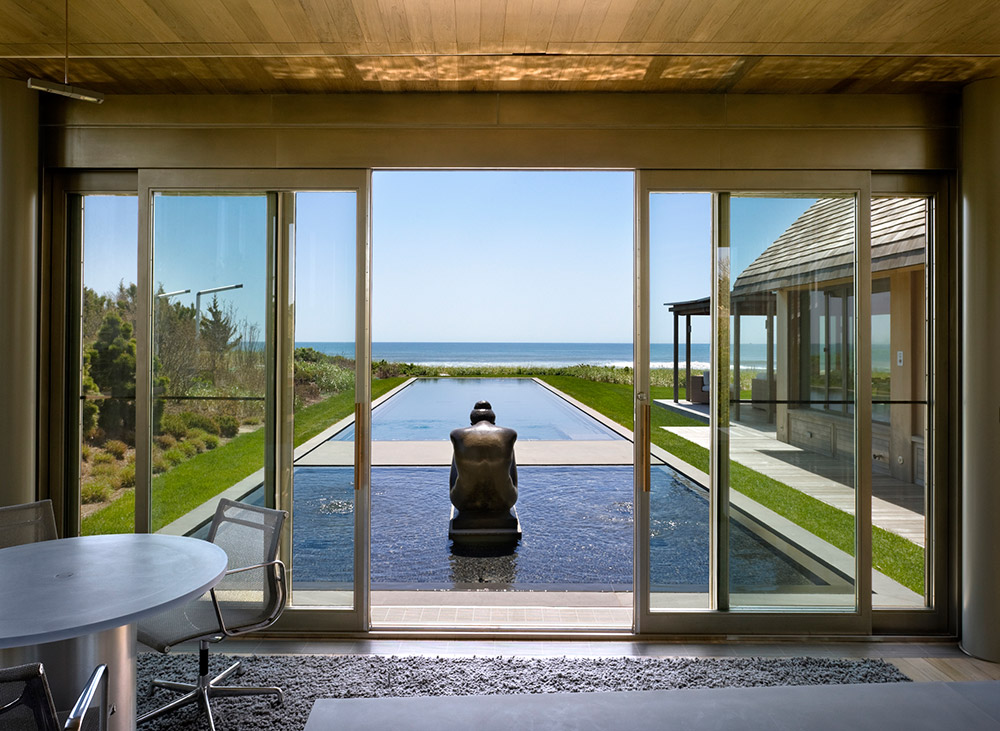
In architecture, water element adds fullness to any space with its physical appearance, natural and symbolic in meaning. In all cultures, water is a part of cleaning and purification associated with sacred values. For Example, water can assume a symbolic mission as an element which might provide a microenvironment for a statue or a symbolic representation when placed with meaningful relics in various ways.
Focus
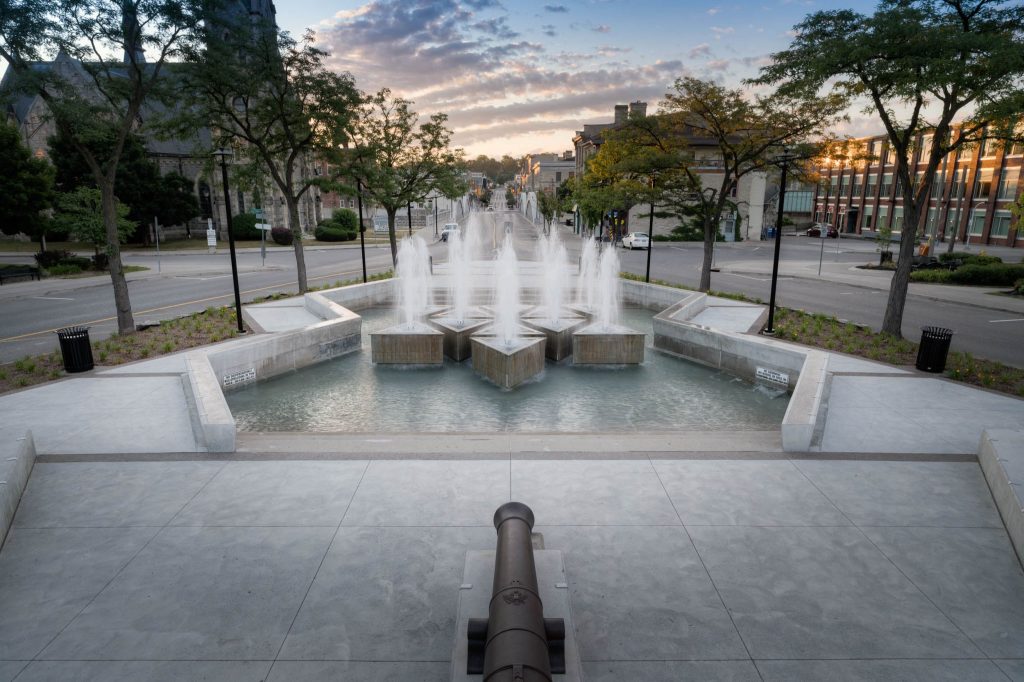
Sometimes, the water element in the space constitutes a controlling element by separating from the general composition of the space functionally, symbolically, or stylistically. This also allows for the use of water as focus. It is a common practice to use the water element in focus where the primary activity of the spaces is for users to gather or wait to get to another space.
The water element as fountains can be placed in a vital point, a square or a pedestrian axis in the urban space can bring a focal point and landmark character to that space and also will add value to space as a landscape element that will provide noise control and encourage people to use that space.
Continuality
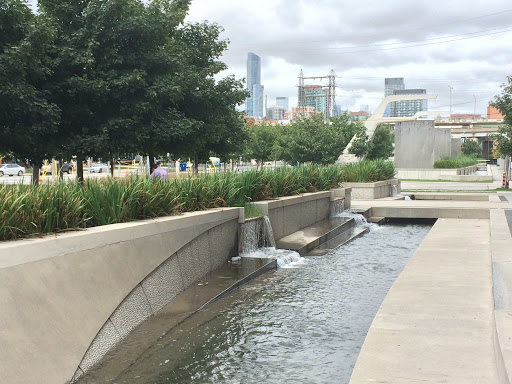
Water can serve in space by arousing a sense of continuality and can moderate the character of the
space. The water element in the space can show a feature of providing continuality when it moves by following a circulation. These types of waterscapes can comply with walking and strolling activity and in public spaces with lot of circulation and movement in general.
There are many reasons for the use of water in the design. Not only are water elements
used to make positive contributions to designs from an aesthetic point, they can also be
used to provide safety or security for recreational purposes.
Water, whether at rest or in motion, strikes the human spirit. The presence of water body
can bring peace to mind whether it is through vision, touch, and sense or by the sound of
the water. It can lift up the mood of an otherwise sedate space or provide much need
tranquility to spaces hustling with activities. The human mind and spirit is always attracted
towards water and water can vastly dictate the emotions of the users in any space.
- Category :
- Type :
Created
April 22, 2020

Recent Comments